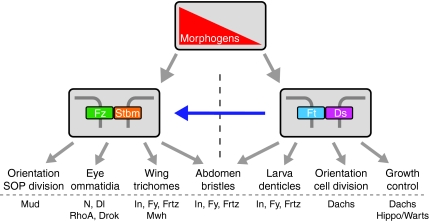Fig. 5.
Relationships between the core and Ft/Ds pathways in Drosophila. Both the core and Ft/Ds pathways can respond independently to upstream morphogenetic patterning information (gradient in red). The core pathway (represented by heterophilic Fz-Stbm binding) interacts directly with effectors to control polarity of trichomes in the wing, the orientation of sensory organ precursor (SOP) divisions, and the DV polarity and rotation of ommatidia in the eye. In these contexts the Ft/Ds pathway can alter polarity via the core pathway (blue arrow) by an unknown mechanism. The Ft/Ds pathway can act independently of the core pathway to mediate effects on growth control, cell division orientation in the wing and eye discs, and the polarity of larval denticles. The Ft/Ds pathway acts in parallel with the core pathway to control trichome and bristle orientation in the abdomen. Example effectors mediating these effects are shown at the bottom. Dl, Delta; Drok, Rho kinase; Ds, Dachsous; Frtz, Fritz; Ft, Fat; Fy, Fuzzy; Fz, Frizzled; In, Inturned; Mud, Mushroom Body Defective; Mwh, Multiple Wings Hairs; N, Notch; Stbm, Strabismus.

